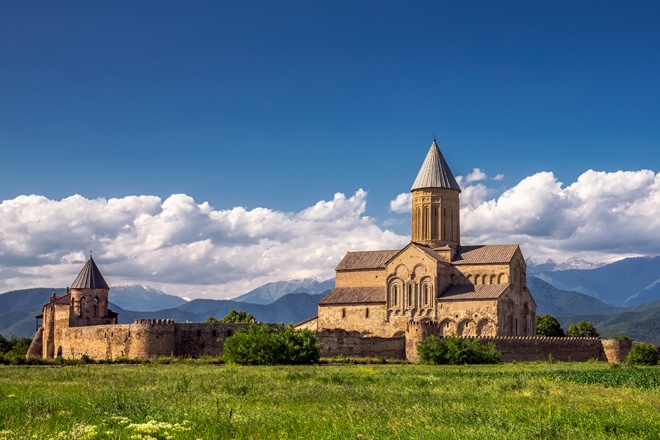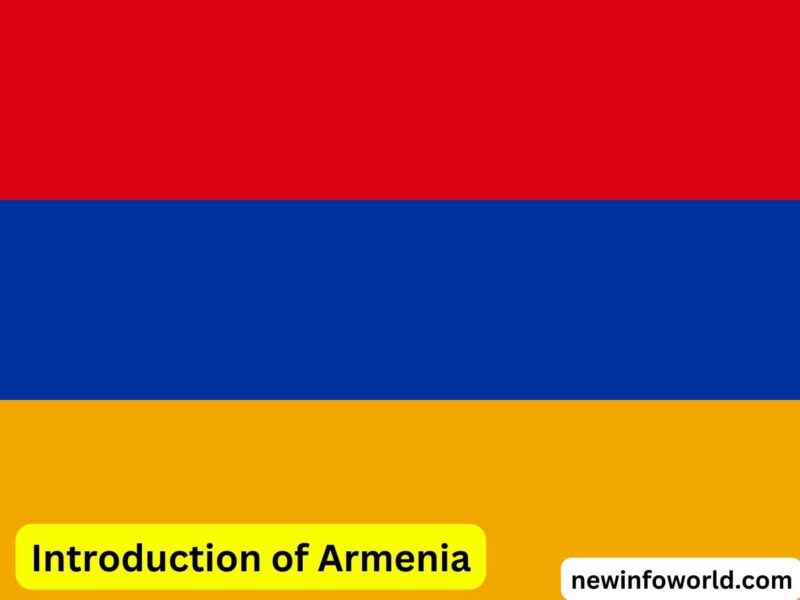Introduction of Armenia is a landlocked country in the South Caucasus region of Eurasia. The country has a rich history, diverse culture, and stunning landscapes, including the famous Mount Ararat.
Introduction Armenia is known for its ancient monasteries, such as Tatev Monastery and Geghard Monastery, and its traditional Armenian cuisine, including dishes like dolma and lavash. The capital city, Yerevan, is a vibrant hub of art, culture, and history, with attractions like the Matenadaran and the Cascade Complex.
The introduction of Armenia also boasts a growing wine industry and is a paradise for outdoor enthusiasts, offering opportunities for hiking, skiing, and rock climbing. With its warm hospitality and unique blend of old and new, Armenia is a destination that offers something for every traveler.

Unveiling Armenia’s History And Heritage
Discover the Introduction of Armenia’s rich history and heritage with detailed and pertinent information about this fascinating country.
Explore its cultural treasures, ancient landmarks, and traditions as you delve into the depths of Armenia’s captivating past and present. Gain an in-depth understanding of Armenia’s significant contributions to the world.
Ancient Origins Of Armenia
The introduction of Armenia has a rich and complex history dating back to ancient times. With traces of human habitation dating back to the Bronze Age, Armenia is widely regarded as one of the oldest civilizations in the world.
The region’s strategic location at the crossroads of Europe and Asia has played a significant role in shaping its history and cultural heritage. The ancient kingdom of Urartu, which thrived around 800 BC, is commonly considered one of the predecessors of the modern Introduction of Armenia.
The Influence Of Historical Events On Armenian Culture
The historical events that have unfolded within Armenia’s borders have left a lasting imprint on its culture and society. From the rise and fall of various empires to the tragedies of genocides and wars, the Armenian people have endured numerous challenges that have influenced their identity and heritage.
These events have not only shaped Armenian art, literature, and architecture but have also instilled a sense of resilience and strength within the Introduction of Armenia spirit.

Credit: www.mountainkingdoms.com
Exploring Armenia’s Diverse Cultural Traditions
Armenia, a country rich in history and culture, boasts a diverse tapestry of traditions that have been preserved for generations. From folk music and dance to delectable traditional cuisine, Armenia’s cultural heritage is a treasure trove waiting to be discovered.
Folk Music And Dance
Traditional Armenian music and dance are an integral part of the country’s cultural identity. Folk music in Armenia is characterized by soul-stirring melodies played on traditional instruments such as the duduk, kamancha, and dhol.
These musical expressions often center around themes of love, nature, and everyday life, reflecting the essence of Armenian tradition and history. As for folk dance, it is a vibrant and graceful art form that embodies the spirit of Armenian culture.
Dance performances often feature intricate footwork, vivid costumes, and expressive movements that depict the country’s historical narratives and collective experiences.
Traditional Armenian Cuisine
Armenian cuisine is a delightful fusion of flavors, drawing on centuries-old recipes and culinary techniques. From hearty meat dishes to abundant fresh fruits and vegetables, Armenian cuisine offers a diverse range of palate-pleasing options.
Some must-try dishes include dolma, khorovats, and lavash, a traditional flatbread. The rich culinary heritage of Introduction of Armenia reflects influences from neighboring countries while maintaining its own unique identity, making it a culinary paradise for food enthusiasts.
Hidden Gems: Armenia’s Unique Landmarks
Armenia, a country rich in culture and history, is home to some of the most fascinating and unique landmarks in the world.
From ancient monasteries perched on rugged cliffs to serene lakes surrounded by breathtaking landscapes, Armenia’s hidden gems offer a glimpse into the country’s historic and natural beauty.
Visiting The Ancient Tatev Monastery
The Tatev Monastery, dating back to the 9th century, is a marvel of the medieval Introduction of Armenian architecture. Set against the dramatic backdrop of the Vorotan River Gorge, the monastery is not only a historical site but also offers spectacular panoramic views of the surrounding mountains.
A ride on the longest reversible aerial tramway in the world, the “Wings of Tatev,” adds an adventurous touch to the journey to this ancient gem.
Discovering The Beauty Of Lake Sevan
Lake Sevan, one of the largest high-altitude lakes in the world, is a hidden treasure in the Introduction of Armenia. The sparkling blue waters of the lake are nestled amidst picturesque landscapes, making it a tranquil escape for nature enthusiasts.
Visitors can explore the Sevanavank Monastery, situated on a peninsula jutting into the lake, and indulge in fishing, boating, and swimming activities.
Armenian Art And Craftsmanship
Armenia is renowned for its rich artistic and cultural heritage, with a vibrant tradition of craftsmanship that has been preserved for centuries. From stunning carpets to intricate stone carvings, Armenian art and craftsmanship reflect the country’s deep historical and cultural significance.
The Significance Of Armenian Carpets
Armenian carpets hold immense cultural and historical significance, dating back thousands of years. They are known for their intricate patterns, vibrant colors, and superior quality.
Armenian carpets are not just beautiful decorations, but they also serve as a means of storytelling and preserving the country’s rich heritage. These carpets are often adorned with symbolic motifs, reflecting Armenian history, mythology, and traditions.
The Art Of Khachkars (cross-stones)
The art of Khachkars, or cross-stones, is a unique and traditional craft deeply rooted in Armenian culture. These intricately carved stone crosses are symbols of spiritual devotion and are often found in Armenian churches and cemeteries.
The intricate carvings on Khachkars depict a blend of Christian and pagan motifs, showcasing the fusion of different cultural influences in Armenian art. The craftsmanship involved in creating these Khachkars is a testament to the skill and dedication of Armenian artisans in preserving their cultural heritage.
Language And Literature In Armenia
The Rich Tradition Of Armenian Literature
The introduction of Armenia boasts a rich and diverse literary tradition that spans centuries, making it a significant component of the country’s cultural heritage. Armenian literature is renowned for its profound storytelling, vivid imagery, and historical themes passed down through generations.
The works of prominent Armenian writers have contributed to the preservation and promotion of the country’s cultural identity and have left a lasting impact on the global literary landscape.
The Heritage Of The Armenian Language
The Armenian language holds a vital place in the country’s cultural and historical landscape. With a history dating back to ancient times, the Armenian language has evolved over the centuries and has been a crucial aspect of Armenian identity.
The richness and complexity of the language have played a pivotal role in shaping the country’s literary traditions and cultural expressions.
Religious Diversity In Armenia
In Armenia, religious diversity is a prominent aspect of the country’s cultural fabric. The historical and contemporary influences of Christianity, as well as the coexistence of different religions, contribute to the rich tapestry of beliefs and traditions in this Eurasian nation.
History And Influence Of Christianity In Armenia
The history of Christianity in Armenia dates back to the early 4th century, making it one of the oldest Christian nations in the world. The adoption of Christianity as the state religion in AD 301 by King Tiridates III played a pivotal role in shaping Armenia’s cultural and religious identity.
The Armenian Apostolic Church, an ancient and distinct denomination, has been a unifying force for the Armenian people throughout centuries of political upheaval and cultural change.
Coexistence Of Different Religions In The Country
Armenia is known for its tolerance and coexistence of various religious traditions, including Christianity, Islam, Judaism, and other faiths. Despite being predominantly Christian, the country respects the rights of minority religious groups, fostering an environment of religious freedom and diversity.
Places of worship for different religions are often found near one another, symbolizing the peaceful coexistence and respect among various religious communities.
Influential Armenian Figures
Celebrated Armenian Poets And Writers
Armenia has produced numerous influential poets and writers whose literary works have made a profound impact on the world. Some of the most celebrated figures in Armenian literature include Hovhannes Shiraz, known for his romantic poetry that reflected the Armenian spirit and culture, and Silva Kaputikyan, a highly respected poet whose works addressed themes of love, patriotism, and human emotions.
Renowned Artists And Musicians From Armenia
Armenia has a rich cultural heritage, and this is evident in the contributions of its renowned artists and musicians. One of the most celebrated artists is Arshile Gorky, known for his contributions to the development of abstract expressionism in the United States.
In the realm of music, Aram Khachaturian stands out as a world-renowned composer whose compositions reflect the rich musical traditions of the Introduction of Armenia.
Celebrating Armenian Festivals And Events
When it comes to the vibrant culture of Introduction of Armenia, partaking in the celebrations of its festivals and events is a truly immersive experience. The Armenian people treasure their traditions and mark significant occasions with great fervor and merriment.
From ancient rituals to modern-day commemorations, the country is brimming with diverse and captivating festivities that offer a unique glimpse into its rich heritage.
Partaking In The Celebrations Of Vardavar
One of the most beloved and lively traditions in Introduction of Armenia is the annual celebration of Vardavar. Held on the 14th Sunday after Easter, this joyful festival is characterized by the playful custom of dousing one another with water.
Participants of all ages engage in spirited water fights, spreading laughter and joy throughout the streets. Additionally, Armenians often exchange flowers as a symbol of goodwill and affection during Vardavar. This exuberant celebration holds deep cultural significance, marking the triumphant arrival of spring and the rejuvenation of nature after the hardships of winter.
The Significance Of Armenian Independence Day
Armenian Independence Day is a momentous occasion that holds profound cultural and historical significance. Celebrated on September 21st, this event marks the country’s liberation from the Soviet Union in 1991. On this day, the nation comes together in patriotic unity to honor its hard-won freedom and reflect on its enduring resilience.
The streets are adorned with the vibrant colors of the Armenian flag, and a sense of national pride pervades the atmosphere. Armenians commemorate this day with grand parades, stirring speeches, and stirring cultural performances, affirming the enduring spirit of their nation.
Contemporary Armenian Culture
The contemporary culture of Armenia is a tapestry of modern art, literature, and an evolving landscape that reflects the country’s rich historical and artistic heritage.
Modern art and literature in Introduction of Armenia are pivotal aspects that encapsulate the spirit of the nation’s cultural expression, while continuously evolving to embrace contemporary perspectives and styles.
Modern Art And Literature In Armenia
The introduction of Armenia boasts a vibrant contemporary art scene that seamlessly weaves together traditional influences with innovative expressions. The modern art movement in Introduction of Armenia encompasses a diverse range of mediums, including painting, sculpture, installation art, and multimedia creations.
Bold, vibrant colors and expressive forms breathe life into the canvases of Armenian artists, offering viewers thought-provoking insights into the country’s social, political, and cultural landscapes. From avant-garde exhibitions to collaborative public art projects, Armenia’s modern art scene provides a platform for artists to engage with global dialogues while staying true to their roots.
Literature holds a cherished place in Armenian culture, with a rich tradition that spans centuries. Contemporary Introduction of Armenia literature continues to evolve, reflecting the pulse of societal changes and the quest for individual and collective identity. It encompasses a myriad of genres, ranging from poetry and fiction to non-fiction and experimental forms.
Emerging Armenian writers are using their literary voices to explore themes of diaspora, identity, and the human experience, resonating with both local and international audiences.
The Evolving Cultural Landscape Of Armenia
The cultural landscape of Introduction of Armenia is in a state of dynamic evolution, as traditional customs converge with modern influences. The country’s artistic identity is shaped by a fusion of heritage and innovation, leading to a renaissance of creative expression across various domains.
Festivals, galleries, and cultural institutions play a pivotal role in nurturing this evolving landscape, serving as platforms for artists, writers, and performers to showcase their work and engage in dialogues that transcend borders.
Preserving Armenian Heritage For Future Generations
The introduction of Armenia, a country brimming with an ancient and rich cultural heritage, has shown remarkable dedication to preserving its traditions for the benefit of future generations. Efforts to safeguard Armenian traditions and the importance of cultural preservation and promotion are crucial components of protecting the legacy and identity of this historic nation.
Efforts To Safeguard Armenian Traditions
The introduction of Armenia has made significant strides in safeguarding its traditions, recognizing the need to protect its cultural identity in the face of modernization. The government and local organizations have implemented initiatives to document, preserve, and promote Armenian cultural practices, such as traditional dance, music, and crafts.
These efforts are crucial in maintaining the cultural fabric that has been woven over centuries.
The Importance Of Cultural Preservation And Promotion
Preserving the Introduction of Armenia’s heritage is not just a matter of nostalgia; it is a vital component of ensuring the holistic development of the nation. Cultural preservation and promotion play a pivotal role in fostering a sense of identity, belonging, and pride among the Armenian populace, while also serving as a significant draw for tourists and cultural enthusiasts from around the world.
Frequently Asked Questions For Introduction of Armenia
Q1: What Are The Top Tourist Attractions In Armenia?
- Armenia offers breathtaking sights such as the ancient Garni Temple, stunning Lake Sevan, and the historic Geghard Monastery.
Q2: Is It Safe To Travel To Armenia?
- Yes, Armenia is considered a safe destination for travelers, with low crime rates and friendly locals welcoming visitors.
Q3: What Is The Traditional Armenian Cuisine Like?
- Armenian cuisine is known for its rich flavors and includes dishes like dolma, lavash bread, and delicious barbecued meats.
Q4: What Is The Best Time Of Year To Visit Armenia?
- The best time to visit Armenia is during the spring and autumn months when the weather is pleasant and the landscapes are beautiful.
Q5: How Can I Experience Armenian Culture And Traditions?
- You can immerse yourself in Armenian culture by visiting local markets, attending traditional festivals, and interacting with the friendly locals.
Conclusion
In light of the detailed information provided, the Introduction of Armenia emerges as a captivating destination filled with rich history, breathtaking landscapes, and vibrant culture. From its ancient landmarks to its warm hospitality, the Introduction of Armenia offers travelers a unique experience. By delving into its fascinating heritage and picturesque surroundings, visitors can uncover the allure of this remarkable country.







